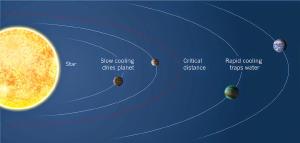Post
Water World
3 June 2013
 Nature
NatureVenus and Earth are quite similar in many ways. The diameter of Venus is about 95% of Earth’s, its mass is about 80% of Earth’s, it has a similar geological make up, and surface gravity. Where they differ greatly is in their surface temperature. Venus has a surface temperature of over 800 degrees Fahrenheit, while Earth’s average temperature is around 57 degrees (460 C vs 14 C for you science types). They also differ in the amount of water they have. Venus has almost no water, while Earth is a watery world.
Given their temperature, you might not think that’s surprising. After all, when your surface temperature is hot enough to melt lead you wouldn’t expect water to hang around. But since Earth and Venus are geologically similar, we would expect them to form in similar ways. We know from its geology that Earth was watery from early on, and we know from the levels of hydrogen and deuterium in Venus’ atmosphere that it too had a wet past. But somehow Venus and Earth diverged.
It has generally been thought that Venus started as a wet world. Thus, Earth and Venus were both wet during their first hundred million years or so, then diverged later. Earth is not only farther from the Sun, it also has a strong magnetic field which Venus lacks. Being more cool and magnetically protected, Earth was able to retain its water, while Venus gradually lost its water due to a higher temperature and solar wind.
But this month in Nature a different model was proposed.1 In this model it is only the distance from the Sun that matters, not the magnetic field or atmospheric temperature. If this model is right it would have major consequences for habitable exoplanets.
According to the model, during the formation of a planet, when its surface is still molten, water vapor from the magma ocean is released into the atmosphere, which saturates the atmosphere. Since water vapor is a greenhouse gas, it holds in much of the heat from the planet. You can calculate the effect of the water vapor, and it turns out that a saturated atmosphere would only allow about 300 watts of heat per square meter to be released from the planet. In other words, there is a fixed rate at which the planet could cool, depending on its size.
This assumes that the planet isn’t gaining any heat from the Sun. However if a planet is closer than a particular distance, the heat from the Sun would heat the planet by more than 300 watts per square meter. This means that as long as the planet’s atmosphere is saturated with water vapor, there is no way for the planet to cool, since it would be taking in as much or more heat than it could possibly lose. As a result, the planet can’t cool until the water in its atmosphere is baked off.
So there is a critical distance from a star which can be easily calculated. If a planet is closer than this distance, its water will largely bake off before it cools, and if it is farther than this distance the planet cools before losing its water. In our solar system Earth cooled quickly, forming a crust and then liquid oceans, while Venus remained hot until it lost its water, then cooled to form a dry world.
It is an interesting model, but at the moment we don’t know enough about Venus’ geological history to determine if Venus lost its water early on as this model proposes, or from some later process. If this model is true, then Earth-mass exoplanets that lie beyond that critical distance are likely to be wet planets. And if they exist in the star’s habitable zone they would likely have liquid oceans similar to ours.
If this model is right, there may be quite a few water worlds in our galaxy.
Hamano, Keiko, Yutaka Abe, and Hidenori Genda. “Emergence of two types of terrestrial planet on solidification of magma ocean.” Nature 497.7451 (2013): 607-610. ↩︎